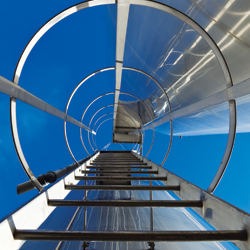In response to the growing awareness that our quality of life depends upon protection of our environment, consumers and regulators are directing their resources towards products less harmful to the environment. The challenge to specifiers is clear: understand the "cradle to grave" characteristics of materials and make ever more satisfying products from ever more benign materials.
In use, stainless steel is durable and requires a minimum of maintenance, outlasting many competing products and eliminating requirements for additional potentially hazardous materials such as paint, fire protective coatings, cleaners and solvents.
Stainless steel is a valuable scrap material. It is 100% recyclable and a preferred raw material input by steel makers. Stainless steel production incorporates high levels of scrap use (as high as 80% of charged materials will be scrap stainless steel). New stainless steel comprises at least 50% recycled stainless steel product and more than half the stainless steel produced today has already been another useful stainless steel product in the past. Even beer kegs wear out eventually. Power is expensive and modern stainless mills operate close to the theoretical minimum.
Despite the very high recycling of old stainless steel products, some stainless steel will find its way to landfills or other disposal sites. In these circumstances no detrimental effect to soil or ground water is expected.
For more information about stainless steel and sustainability, please visit www.sustainablestainless.org.


